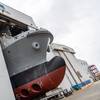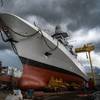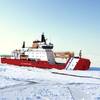Gas Turbines Give Austal Strategic Military Edge
Dubbed the "X-Craft," the 262-ft. (80-m) catamaran will feature twin LM2500 gas turbines and be capable of speeds of approximately 50 knots. Prime contractor for the project is San Diego-based Titan Systems Corporation, which has selected Austal USA as one of five shipyards to participate in the final tender round. The tender closes early in 2003, with delivery of the independently-designed aluminum catamaran scheduled for mid-2004.
In bidding for the project, Austal USA has been able to draw upon the extensive high speed catamaran experience of its parent company, Austal Ships of Western Australia. Among the more than 60 fast catamarans built by the yard are six fast ferries powered by gas turbines, including the 282-ft. (86-m) catamaran Villum Clausen. In February 2000 this vessel claimed the world record for the longest distance traveled by a ship in a 24-hour period.
Villum Clausen's propulsion plant is comprised of two 18,000-kW GE LM2500 gas turbines each driving a pair of steerable waterjets via single-input, dual output gearboxes. During its record-breaking journey, the ship covered a distance of 1,063 n.m. at an average speed of 44.2 knots.
Austal's familiarity with the LM2500 is particularly relevant for defense applications, with 29 of the world's navies using this gas turbine model. Significantly, in the early 1970s the United States Navy selected the LM2500 series engine as the prime mover for propulsion on the Spruance (DD963) Class destroyers.
Austal Ships' advanced hullform technology forms the basis of the team's FMHSS which will be capable of speeds in excess of 50 knots as well as providing outstanding efficiency and performance in all sea conditions, endurance and reliability for sustained independent operations and shallow draft for operations in the littoral environment. The FMHSS study will assist the U.S Navy in defining requirements for the rapidly emerging Littoral Combat Ship (LCS) Program, which is expected to involve the construction of between 30 and 60 ships starting in 2005.













